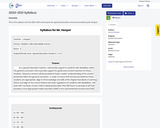
This is the syllabus for the 2020-2021 school year for special education services provided by Mr. Hooper.
- Subject:
- Special Education
- Material Type:
- Syllabus
- Author:
- Jamie Hooper
- Date Added:
- 06/10/2020

This is the syllabus for the 2020-2021 school year for special education services provided by Mr. Hooper.

A clear outline for student expectations during rehearsals, class, tech week, and/or production days.Keep them focused and accountable and modify to fit the needs of your program.Can be used for class syllabus or after school/in class productions.

The Portuguese language lessons of ClicaBrasil highlight aspects of Brazilian culture. They are designed for intermediate to advanced students, but are accessible to everyone. Each lesson includes videos of Brazilians from all walks of life speaking naturally about their lives and their country. All lessons integrate reading, writing, listening and comprehension, grammar, vocabulary, oral communication and cultural activities with the videos. This is also available as a free PDF textbook and as print on demand.

Planning tools and resources for planning a comprehensive school counseling program. Please note the following templates are in draft form. We are asking school counselors to “field test” them and provide feedback before we publish them for statewide access.

Français interactif is a unique, award-winning 1st-year French curriculum used by learners all over the world. Students explore French language and culture by following the lives of real students who have participated in the UT Summer Program in Lyon, France. The online curriculum includes over 320 videos, vocabulary and phonetics audio, online grammar reference with self-correcting exercises and audio dialogues, verb conjugation and practice tools, internet activities, and a textbook of classroom exercises. Franais interactif was awarded the 2009 CALICO Esperanto Access to Language Education Award and the National Endowment for the Humanities EDSITEment Best of Humanities on the Web award (2005)

Rockin Russian is designed to give students exposure to the Russian language and culture through the medium of Russian music videos. Students are able to perfect their grammar while rocking out to music videos from Russia's pop stars. Based on Russian music videos from MTV Russia, Rockin' Russian is supplemented with exercise materials focusing on pronunciation, vocabulary development, grammar and cultural features. Parts of the videos are embedded into exercises in each category that students can revisit, strengthening their language skills.

Starting documentation for a science fair or similar science investigation project.

Syllabus for Teacher Use. 8th Grade MathParents and Students will receive a copy for Back to School Week!

imagi offers inclusive, fun, and easy-to-use tech education tools including a platform to learn how to code at school.
imagi Edu is a free website (Chrome) and tablet app (iPad and Android) that includes a Python code editor, classroom management tools, and detailed lesson worksheets and slides! These resources are ideal for kids ages 8-14+ and their educators.